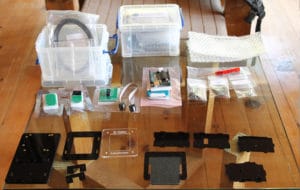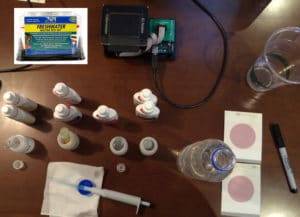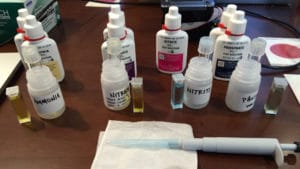I had the joy of traveling to Bhutan in November 2015 with a delegation from Stroud Water Research Center and Waterkeeper Alliance. Among our goals was to provide our Bhutanese colleagues at Clean Bhutan and government agencies with water quality monitoring tools and methods that are low cost, accurate, sustainable, and adaptable to their needs to help them monitor their own water quality.
 Shannon Hicks and Sarah Damiano tracked down an open source colorimeter based on the Arduino electronics platform and developed by the IO-Rodeo company. The kit is intended as a teaching tool, but doubles as an excellent and affordable citizen science tool. The benefit of colorimetry to “read” the results of aquarium-quality test kits, is that the error introduced in these kits is largely due to our ability to color match with our eyes. Using colorimetry with consumer-grade test kids greatly enhances the accuracy and reproducibility of results, while maintaining affordability and accessibility to the testing solutions. I assembled and deployed the IO-Rodeo colorimeters in Bhutan and want to share this technology with the EnviroDIY community.
Shannon Hicks and Sarah Damiano tracked down an open source colorimeter based on the Arduino electronics platform and developed by the IO-Rodeo company. The kit is intended as a teaching tool, but doubles as an excellent and affordable citizen science tool. The benefit of colorimetry to “read” the results of aquarium-quality test kits, is that the error introduced in these kits is largely due to our ability to color match with our eyes. Using colorimetry with consumer-grade test kids greatly enhances the accuracy and reproducibility of results, while maintaining affordability and accessibility to the testing solutions. I assembled and deployed the IO-Rodeo colorimeters in Bhutan and want to share this technology with the EnviroDIY community.
The colorimeters arrive in a nicely-packaged kit which serves as a protective storage case for the assembled product. IO-Rodeo provides clear assembly instructions, but sadly as a web interface, not as a downloadable PDF. Thankfully someone realized this before we arrived in Bhutan, where internet connectivity was not always dependable, and printed the whole thing for us. The first colorimeter took me around 30 minutes to assemble, and consecutive kits took less time.
 IO-Rodeo provides calibration curves for many existing water test kits. We chose the API freshwater test kits, available on Amazon. Connecting to the Arduino interface and loading the calibration curves was fast and smooth. By carefully following the instructions by IO-Rodeo and the API kit, I installed, connected, calibrated, and was measuring samples within 30 minutes.
IO-Rodeo provides calibration curves for many existing water test kits. We chose the API freshwater test kits, available on Amazon. Connecting to the Arduino interface and loading the calibration curves was fast and smooth. By carefully following the instructions by IO-Rodeo and the API kit, I installed, connected, calibrated, and was measuring samples within 30 minutes.  We pipetted 5.0 mL of water sample into each of the four test-tubes provided in the API kit. The water samples reacted with colorimetric reagents for ammonia, nitrite, nitrate, and phosphorus. After each reaction, the respective nutrient species were quantified using the IO-Rodeo Colorimeter connected to a computer. In addition to the provided curves, the IO-Rodeo Colorimeter software is extremely simple and capable of accommodating user-defined calibration curves.
We pipetted 5.0 mL of water sample into each of the four test-tubes provided in the API kit. The water samples reacted with colorimetric reagents for ammonia, nitrite, nitrate, and phosphorus. After each reaction, the respective nutrient species were quantified using the IO-Rodeo Colorimeter connected to a computer. In addition to the provided curves, the IO-Rodeo Colorimeter software is extremely simple and capable of accommodating user-defined calibration curves.

 Welcome to EnviroDIY, a community for do-it-yourself environmental science and monitoring. EnviroDIY is part of
Welcome to EnviroDIY, a community for do-it-yourself environmental science and monitoring. EnviroDIY is part of